Lately I’ve been having a lot of conversations around investment terms with searchers, as well as investors.
About 15 years ago, I interned at a search fund. And, over the last few years, I’ve started to invest in the asset class going direct as well as through funds of search funds.
Investing in search funds is a great way to scratch my entrepreneurial itch, extremely rewarding when a searcher finds success, and can be economically rewarding too.
This post is my attempt to share thoughts on self funded search economics in an effort to contribute to the search fund community, get feedback on my thinking from a wider audience, and of course meet more people who are doing searches/investing and may want to collaborate (please feel free to reach out!).
You can watch a video of me explaining this model here, and download the excel here:

Enterprise Value
The standard finance equation is enterprise value = debt + stock – cash. Enterprise value is how much the company itself is worth. Many times people confuse it with how much the stock is worth and find the “minus cash” part of this really confusing.
So, you can rearrange this equation to make it stock = enterprise value – debt + cash. Make more sense now?
Enterprise value is just how much you’re willing to pay for the company (future cash flows, intellectual property, etc), not the balance sheet (debt and cash).
Most investors and searchers think about the EBITDA multiple of a company on an enterprise value basis because they’ll be buying it on a cash free, debt free basis. It becomes second nature to think about EBITDA multiples and know where a given business should fall given scale, industry, etc.
However, I believe this second nature way of thinking of things can be a massive disadvantage to investors given the way EV and multiples are talked about in our community currently.
Sources of capital, the typical way to calculate enterprise value for self funded searchers
If you’ve ever looked at or put together a teaser for a self funded search deal, you will notice that the deal value is equal to the sum of the sources of capital minus deal fees and cash to the balance sheet.
As a simple example, if there is $4 mm of debt to fund the deal, $1 mm of equity, and $200k of deal fees, the enterprise value = $4 mm + $1 mm – 200k = $4.8 mm.
We’ll use slightly more complex numbers in our example: If a searcher is taking a $3.2 mm SBA loan, $850k seller note, putting in $120k themselves, getting $350k of equity from the seller, a $500k earnout, and $1.2 mm of equity financing minus $350k to the balance sheet and $250k of deal fees, then the enterprise value will be $5.62 mm.
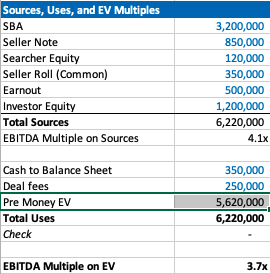
Our example company has $1.5 mm of EBITDA, so the EBITDA multiple is 3.7x. This is a pretty attractive acquisition multiple for a business that meets traditional search criteria (recurring revenues, fragmented competition, high gross margins, low customer concentration, etc).
If you’re seeing a search fund deal for the first time, the headline of “we’re buying a decent company for 3.7x, and replacing a tired owner with a hungry operator” is pretty exciting!
However, if you’re an investor, there is some nuance to this enterprise value number and the true EBITDA multiple you are investing in.
The trick with self funded enterprise value
The security that most self funded search investors get in a deal is participating preferred stock with a paid in kind dividend. This means when there’s an exit, you get your money back before any other equity holder, then get a certain percent of the business, and whatever dividend you’ve been owed in the interim accrues to your principle.
It’s a really favorable security for the investor, and one that is basically impossible to get in VC where straight preferred stock is much more common (no pun intended).
The key terms are what percent of common equity does this security convert into after the originally principal is paid back, and what is the dividend.
The share of common equity the investor group will get typically ranges from 10-50% of the total common stock. The dividend rate is usually 3-15%. The average I’m seeing now is around 30% and 10% for common and dividends respectively.
The strange this about the enterprise value quoted to investors in a teaser/CIM is that it doesn’t change as the percent of common changes, even though this has large implications for how much the common equity is worth and the value investors receive.
For example, I may get a teaser where the sources of investment – cash to balance sheet – deal fees = $3.7 mm for a $1 mm EBITDA company, which would imply a 3.7X EBITDA multiple. Let’s say the searcher is offering investors 30% of the common and a 10% dividend.
Let’s now say that the searcher is having a tough time raising capital and changes their terms to 35% of common and a 12% dividend. Does the effective enterprise value change for investors? I would argue yes, but I would be surprised to see it changed in the CIM/teaser.
This isn’t a knock on searchers or the search fund community. It’s just kind of how things are done, and I think this is mostly because it’s really hard to think about how the enterprise value has changed in this scenario.
However, the natural way of using EBITDA multiples to think about value for a business that is so common in PE/SMB can be extremely misleading for investors here. You may be thinking 3.7X for this type of business is a great deal! But, what if the security you’re buying gets 5% of the common?
If you’re in our world, you may counter this point by saying most searchers will also supply a projected IRR for investors in their CIM. However, IRR is extremely sensitive to growth rate, margin expansion, and terminal value. While the attractiveness of the security will be reflected, it can be greatly overshadowed by lofty expectations.
To get more clarity and have a slightly different mental model on the effective price investors are paying for this business, let’s go back to basics. Enterprise value should be debt + preferred stock + common stock – cash.
We know the values of each of these numbers, except the common. So, the main question here becomes: how much is the common equity worth?
Calculating value of common equity for self funded search funds
Equity value for most search fund deals = preferred equity from investors + the common equity set aside for the searcher and sometimes also advisors, board, seller.
We know that the preferred equity is investing a certain amount for a certain amount of common equity. The rub is that they are also getting a preference that they can take out before any common equity gets proceeds, and they are getting a dividend.
So, the exercise of valuing the common equity comes down to valuing the preference and dividend.
In my mind, there are three approaches:
- The discount rate method where you take the cash flows you’ll get in the future from the pref/dividends and discount them back at the discount rate of your choice. I am using 30% in my model which I believe accurately compensates investors for the risks they are taking in a small, highly leveraged investment run by an unproven operator. If you believe in efficient markets, this number also fits as it mirrors the historical equity returns as reported by the Stanford report, with a slight discount given this asset class has clearly generated excess returns relative to other assets on a risk adjusted basis, hence interest in these opportunities from an expanding universe of investors.
- The second method is to calculate how much money you’d get from your preference and dividends, taking into account that per the Stanford study around 75% of search funds will be able to pay these sums, and then discount these cash flows back at a rate more in line with public equities (7% in my model). This yields a much higher value to the preference/dividend combo, and therefore lowers the implied value of the common equity.
- The last method is to just say nope, there is no value to the preference and dividend. I need them and require them as an investor, but they are a deal breaker for me if they aren’t there, and therefore they don’t exist in my math. This of course makes no logical sense (you need them, but they also have no value?), but I’ve left it in as I think many investors probably actually think this way and it creates a nice upper bound on the enterprise value. Side note, as with obstinate sellers, jerk investors are usually best avoided.
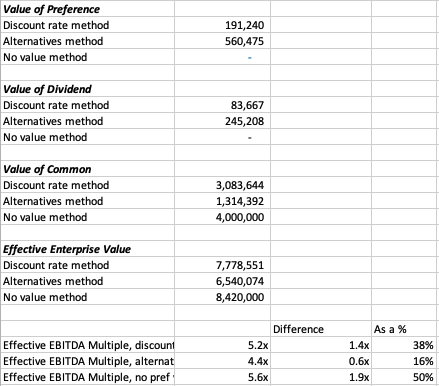
In our example, you can see a breakdown of the preference value, dividend value, and therefore common value and enterprise value for this deal.
In each case, the effective EBITDA multiple moves from 3.7x to something much higher (see the last 3 lines).
There are some simplifying assumptions in the model (no accruing dividend, all paid in last year), and some weird stuff that can happen (if you make the hold time long and the dividend greater than the 7% equity discount rate, the value of the dividend can get really big).
These flaws aside, I think this creates a nice framework to think through what the common is actually worth at close, and therefore what enterprise value investors will be paying in actuality.
It’s worth noting that the whole point of this is to benchmark the value you’re getting relative to market transactions in order to understand where you want to deploy your capital.
This creates a method to translate cash flow or EBITDA multiples of other opportunities on an apples to apples basis (if only there were a magical way to translate the risk associated with each as well!).
Another note, we could calculate the value of the common to be what this asset would trade at market today in a well run auction process minus any obligations (debt, preference, seller financing). However, I think that understates the option value inherent in this equity, a value that is only realized when a new manager takes over with more energy and know how.
There is a finance nerd rational for this. If you plot the value of equity in a leveraged company on a chart, it mirrors the payout of a call option. In both cases, the value of the security increases at a certain inflection point: when the value of equity rises above the strike price in an option, and when the enterprise value of a company rises above the debt level in a levered company.
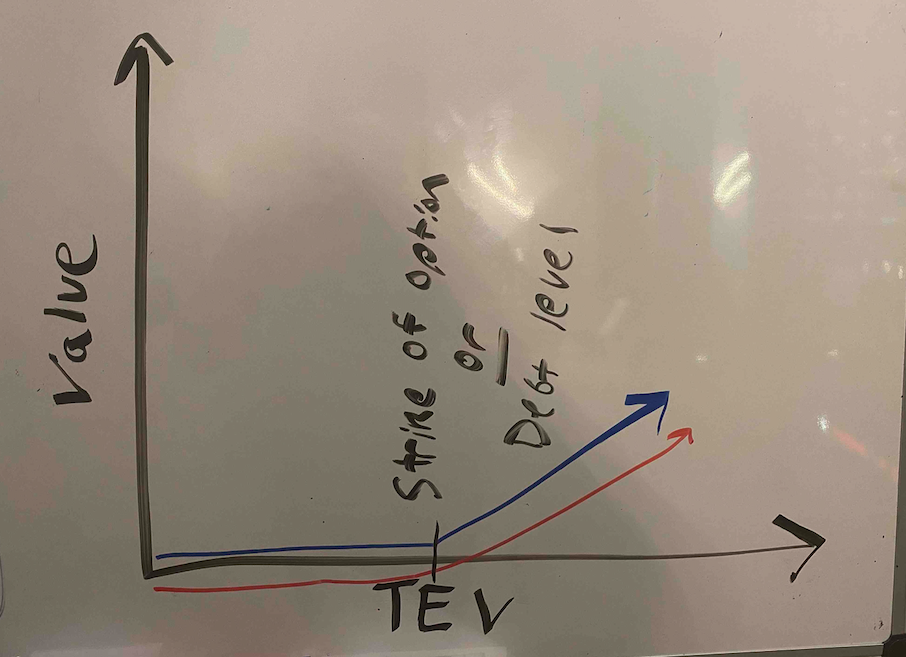
The common equity of a highly levered company can therefore be valued by a similar methodology as the call option: Black Scholes. If you remember back to finance class, increasing volatility will increase the value of an option.
In the search fund case, we’ve (hopefully) increased the (upside) volatility and therefore create more value than simply selling the company today.
A few more thoughts on investor economics
There are a few other ways to think about the economics you get as an investor to best understand if this is the deal for you.
First, you may want to think about how much your investment will be worth day 1. The key lever in this model is what discount this company is being bought for relative to fair market value. For example, the searcher may have proprietary sourced a great company and is buying it for 25% below what it would trade at in a brokered auction.
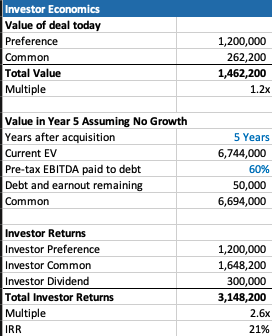
This is very much a “margin of safety” philosophy on things. Same with the calculation on how much you’ll receive in year 5 (after QSBS hits) assuming no growth in the business.
The only problem with each of these calculations is that they never play out in practice. Most companies don’t just stay the same, you’re either in a rising tide or you’re in trouble. And, you’re almost never going to sell in year 1, and definitely not for a slight premium to what it was bought for.
However, if your investment is worth 30% higher day one, and you can make a 20% IRR assuming nothing too crazy happens either way in the business, that’s not a bad place to start. Add in a strong searcher, decent market, some luck, and you’re off to the races.
Thoughts on searcher economics
A lot of this post has considered things from the investor perspective as my main quandary was related to how to create an EBITDA multiple that made sense for investors.
However, the point of this post is not to say searchers are misrepresenting or being unrealistic with their terms. In fact, I think it’s quite logical that self funded searchers capture the massive economic value that they do.
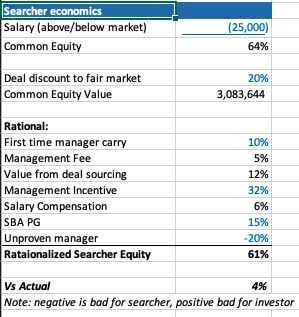
There are many reasons why self funded searchers deserve the lion share of the common equity.
First, they are providing a nice service of giving investors a positive expected value home to park their money with much lower correlation to the market than other asset classes ($1 mm EBITDA companies don’t see lots of multiple contraction/expansion throughout cycles).
Most money managers that fit that criteria are taking a 2/20, of course they also usually have a track record. So, I’ve used a 10% carry in my model, but stuck to 2% annual management fee.
The searcher spent a lot of time, and probably money, finding this company. That’s a lot of value, especially if it’s a below market price. They should be able to capture a lot of the value in finding a below market deal.
The searcher may be taking a below market salary, and needs to get comped like any CEO, with stock options. In my example model I have $1 mm of stock vesting over the hold period, as well as extra comp for taking a below market salary.
Searchers are also usually putting their financial standing at risk by taking a personal guarantee on the bank/SBA loan. This is really tough to put a number on, as is the last line in my framework where searchers are dinged for lack of experience. Like any good model, you need a few lines that you can fudge to make the math work 🙂
What you do think?
I’m shocked that I wrote all this. I was going to type a few paragraphs and a quick excel. However, putting this to paper has been a great exercise for me to sharpen my thinking.
Now I’d like you to help me further. Where do you think this should be changed in this framework? How do you think about things from the investor and/or searcher side?
Feel free to shoot me a note if you have thoughts (even just to tell me I’m being way too academic with this, which I actually agree with).
Lastly, a post like this is really a trap I’m putting on the internet to catch any like minded people in so that we can figure out ways to collaborate now or in the future. So, at the very least, connect with me on LinkedIn 🙂
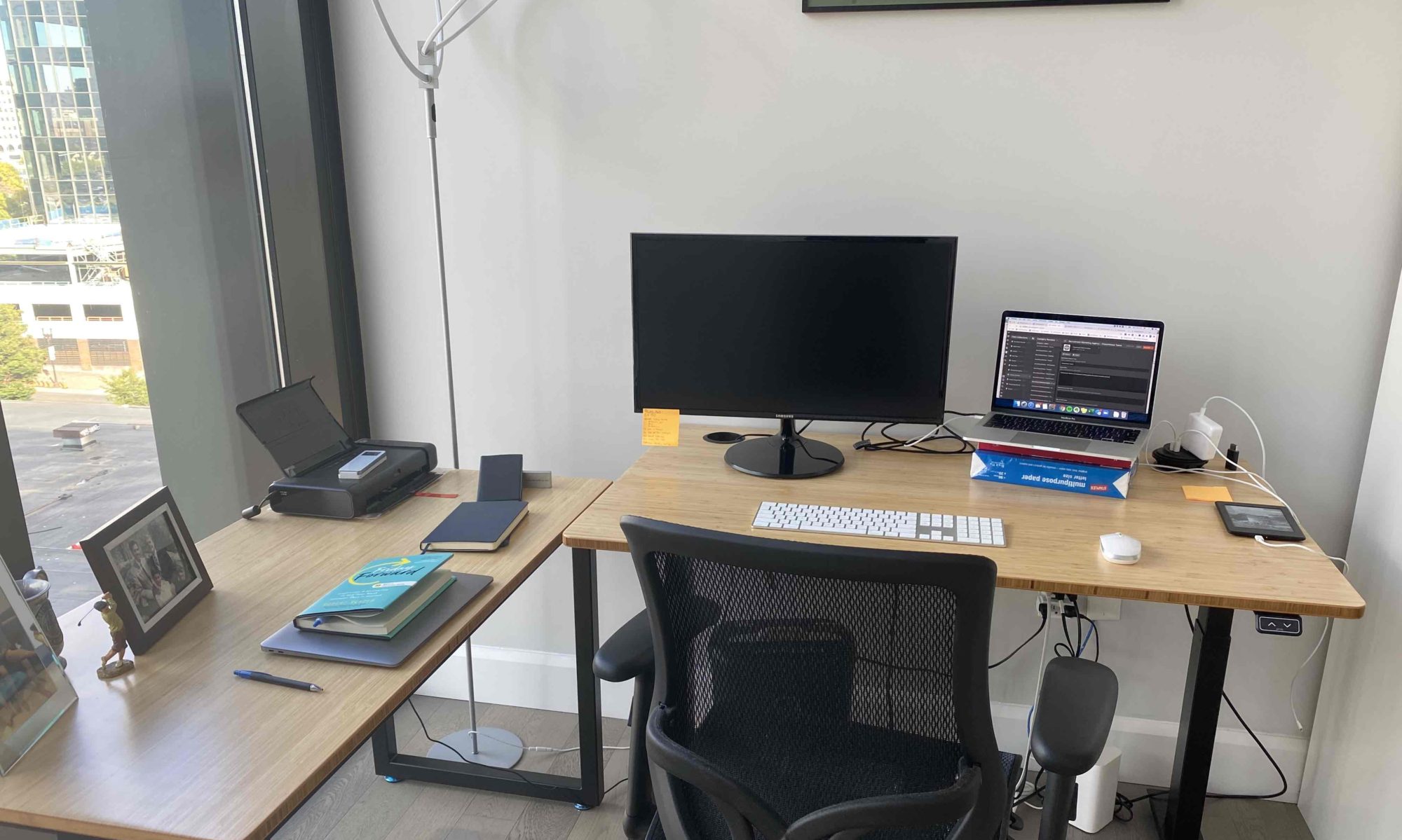
The goal of vision therapy can be to strengthen the muscles of the eyes.
It may also serve as a method to enhance the eye’s vision and assist in tracking.
Vision therapy is a method to treat a range of disorders that affect both adults and children.
WOW just what I was searching for. Came here by searching for phonographic.science
Today, I went to the beach front with my kids. I found
a sea shell and gave it to my 4 year old daughter and said “You can hear the ocean if you put this to your ear.” She placed
the shell to her ear and screamed. There was a hermit crab inside and it pinched her ear.
She never wants to go back! LoL I know this is completely off topic but I had to tell someone!
Thanks for some other excellent post. Where else could anybody get that kind of info
in such a perfect approach of writing? I’ve a presentation subsequent week, and I am on the look
for such information.
My relatives always say that I am wasting my time here at web, however
I know I am getting familiarity every day by reading
such pleasant content.
Hey would you mind stating which blog platform you’re working with?
I’m planning to start my own blog in the near future but I’m having a tough
time choosing between BlogEngine/Wordpress/B2evolution and Drupal.
The reason I ask is because your design and style seems different then most blogs and
I’m looking for something completely unique.
P.S Apologies for being off-topic but I had to ask!
Undeniably believe that that you stated. Your favorite justification seemed to be on the net the simplest factor to be mindful of.
I say to you, I certainly get annoyed whilst folks think
about worries that they just do not understand about.
You managed to hit the nail upon the top as well as outlined out the
whole thing without having side effect , folks could take a signal.
Will likely be back to get more. Thank you
Attractive section of content. I just stumbled upon your
site and in accession capital to assert that I get actually enjoyed account your blog posts.
Any way I’ll be subscribing to your feeds and
even I achievement you access consistently rapidly.
Pretty nice post. I just stumbled upon your
blog and wanted to say that I’ve truly enjoyed surfing around your blog posts.
In any case I’ll be subscribing in your rss feed and I hope you write again very soon!
I have learn some excellent stuff here. Certainly price bookmarking for revisiting.
I wonder how a lot effort you place to create this kind
of magnificent informative site.
valuable review. On top of that visit the particular site to master agen slot pulsa.
This page has received approval from game slot gaming contributors in Indonesia.
So there are a great deal of beautiful promos by means
of chance you actually join now.
Sweet blog! I found it while browsing on Yahoo News.
Do you have any suggestions on how to get listed in Yahoo News?
I’ve been trying for a while but I never seem to get there!
Cheers
Thank you, I have just been searching for info approximately this subject for a long time and yours is the
greatest I’ve discovered till now. But, what about
the conclusion? Are you sure concerning the source?
I know this if off topic but I’m looking into starting my own blog and was wondering what all is required to
get setup? I’m assuming having a blog like yours would cost a
pretty penny? I’m not very web savvy so I’m not 100% sure.
Any suggestions or advice would be greatly appreciated. Kudos
If you want to improve your experience simply keep visiting this site and be updated with the most
up-to-date information posted here.
Wow! In the end I got a web site from where I be able to genuinely get valuable information concerning
my study and knowledge.
Hello, I enjoy reading all of your article. I like to write a little comment
to support you.
Very nice post. I just stumbled upon your blog and wanted to say that I’ve
truly enjoyed surfing around your blog posts.
After all I’ll be subscribing to your feed and I hope you
write again soon!
hello!,I really like your writing so so much! proportion we communicate extra approximately your article on AOL?
I require an expert on this house to unravel my problem.
Maybe that is you! Looking ahead to see you.
Hey there! This is kind of off topic but I need some
advice from an established blog. Is it tough to set up your
own blog? I’m not very techincal but I can figure things out pretty quick.
I’m thinking about setting up my own but I’m not sure
where to begin. Do you have any ideas or suggestions?
Thank you
Thank you for sharing your info. I truly appreciate your efforts
and I am waiting for your further post thanks once again.
If I’m reading the internet, quite often I like to read writings I uncover.
Generally, I am able to uncover new data, or maybe a
unique means of thinking about points that I had
not regarded in the past. When this happens, I’m usually grateful.
Considering that I don’t have the chance to search
online a lot, because of my work as an in-home massage therapist, I aim
to make the most of my activities on-line. https://njmassage.info/
This piece of writing gives clear idea in support of the new visitors of blogging, that in fact how to do running a
blog.
What’s up, after reading this remarkable article i am also happy to share my experience here with mates.
exhilarating review. In addition visit expected site to find out game
slot. This incredible web page has received fascination through situs slot online gambling
house individuals in Negara sendiri. Now there are many
thrilling promos whenever you join currently.
Because the admin of this web site is working,
no question very rapidly it will be renowned,
due to its quality contents.
Hi there, everything is going perfectly here and ofcourse
every one is sharing facts, that’s genuinely good, keep up
writing.
I do agree with all of the concepts you’ve introduced for your post.
They’re really convincing and will definitely work. Still, the posts are too brief
for newbies. May you please prolong them a little from next time?
Thanks for the post.
I like the helpful information you provide in your
articles. I will bookmark your blog and check again here regularly.
I am quite sure I will learn lots of new stuff right
here! Good luck for the next!
Thanks very nice blog!
Vision therapy can assist in helping strengthen the eye muscles.
It is also used as a method to enhance eyesight and aid in tracking.
Vision therapy is a method to treat various disorders that
be affecting both adults and children.
My site; how to improve eyesight naturally at home
Wow! This blog looks exactly like my old one! It’s on a totally different topic but it has
pretty much the same layout and design. Superb choice of colors!
Greetings I am so happy I found your blog,
I really found you by error, while I was searching on Digg for
something else, Anyways I am here now and would just like to say cheers for a
marvelous post and a all round exciting blog (I also love the theme/design), I don’t
have time to browse it all at the moment but I have saved it and also added your
RSS feeds, so when I have time I will be back to read a great deal more,
Please do keep up the fantastic job.
Thankfulness to my father who told me concerning this weblog, this website is truly amazing.
Usually I don’t learn article on blogs, but I wish to say that this write-up very pressured me to try and do so!
Your writing style has been surprised me.
Thanks, very nice post.
Some doctors specialize in a particular area of therapy known as vision therapy.
Vision therapy can also involve exercises for the eyes.
This can however only be performed under the care of an optometrist or an eye doctor.
Also visit my homepage improve eyesight
Hey there! I just want to give you a huge thumbs up
for the great info you have here on this post.
I will be returning to your web site for more soon.
Spot on with this write-up, I actually feel this website needs a
great deal more attention. I’ll probably be back again to read through more, thanks for the advice!
Hi there, this weekend is pleasant in support of me, since this occasion i
am reading this impressive informative article here
at my home.
Superb, what a blog it is! This website presents valuable facts
to us, keep it up.
Wow, superb blog format! How long have you ever been blogging for?
you make running a blog glance easy. The full look of your website
is great, let alone the content material!
Thanks for sharing your thoughts about livebookmark.stream.
Regards
The aim of vision therapy is to strengthen the muscles of
the eyes. It can also help improve your vision and help correct issues with eye tracking.
Vision therapy is a method to treat various disorders that affect both adults and children.
Also visit my blog: are carrots good for your eyes
It is in point of fact a nice and useful piece of information. I’m satisfied that you simply shared this helpful information with us.
Please keep us informed like this. Thanks for sharing.
Thankfulness to my father who informed me about this web
site, this web site is actually awesome.
Hello my friend! I want to say that this article is amazing,
great written and include approximately all important infos.
I would like to look extra posts like this .
Hi there! This post couldn’t be written much better!
Going through this post reminds me of my previous roommate!
He always kept preaching about this. I will forward this
article to him. Pretty sure he’s going to have a great read.
Many thanks for sharing!
Your style is really unique compared to other people I have read stuff from.
Thank you for posting when you have the opportunity, Guess I will just bookmark this site.
Good article. I am experiencing many of these issues as well..
Its like you read my mind! You appear to know a lot about this, like you
wrote the book in it or something. I think that you can do with some pics to
drive the message home a little bit, but other than that, this
is excellent blog. A fantastic read. I will definitely
be back.